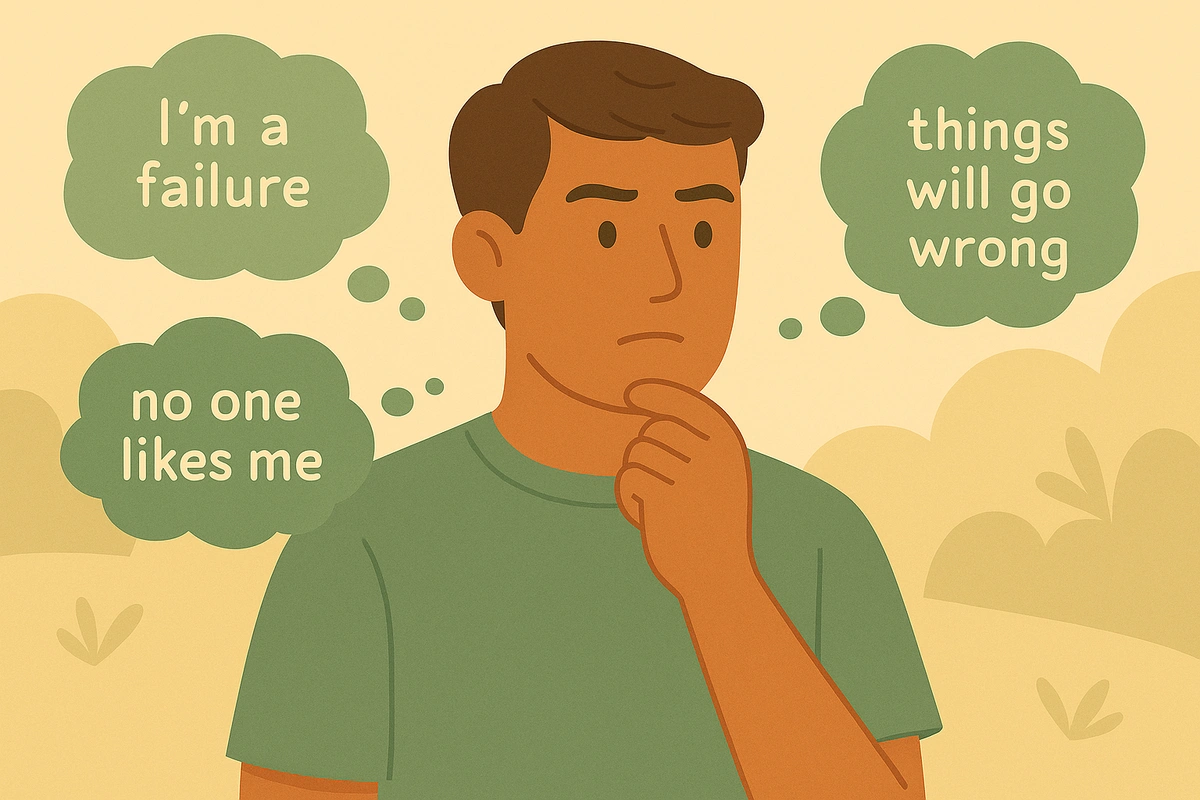Identifying cognitive distortions is a powerful mental health skill that helps you recognize and challenge the automatic negative thought patterns that fuel anxiety and depression, leading to more balanced thinking and improved emotional well-being.

Cognitive distortions are like mental tricks your brain plays on you - automatic thought patterns that twist reality in negative ways, making situations seem worse than they actually are. Think of them as faulty filters that color your perception, similar to how a dirty camera lens makes everything look blurry or dark.
Your brain naturally tries to make sense of complex situations by taking mental shortcuts, but sometimes these shortcuts lead you astray. When you're stressed, anxious, or depressed, your mind becomes more likely to jump to worst-case scenarios, see everything in black and white, or blame yourself for things beyond your control. Learning to spot these distorted thoughts is like becoming a detective of your own mind - once you can identify the culprits, you can challenge them and develop more accurate, balanced thinking patterns that support your mental health.
Cognitive distortion identification works by engaging your brain's natural ability to observe and evaluate its own thinking processes - a skill scientists call metacognition. When you step back and examine your thoughts objectively, you activate your prefrontal cortex, the brain's CEO that's responsible for logical analysis and emotional regulation.
Your brain's emotional center, called the amygdala, acts like a smoke detector that's sometimes overly sensitive. When it perceives threat or stress, it can trigger automatic negative thoughts before your logical brain has time to evaluate the situation accurately. Think of cognitive distortions as false alarms from this overprotective system.
Research in cognitive behavioral therapy shows that simply naming and labeling distorted thoughts reduces their emotional impact. This process, called cognitive defusion, creates psychological distance between you and your thoughts - instead of being trapped inside the distortion, you can observe it from the outside like a scientist studying data.
The technique works because it interrupts what psychologists call the cognitive-emotional cycle. Negative thoughts trigger negative emotions, which then generate more negative thoughts, creating a downward spiral. By catching and challenging distorted thoughts early in this cycle, you prevent the spiral from gaining momentum and developing into anxiety or depression.
Studies demonstrate that people who regularly practice cognitive restructuring actually change their brain patterns over time. The neural pathways associated with balanced thinking become stronger, while the automatic negative thought patterns weaken - similar to how walking a new path through a field eventually creates a clear trail while the old path grows over from disuse.
"I can't identify any distortions in my thoughts" - Start with obvious examples from worksheets or online resources before analyzing your own thinking. Practice identifying distortions in hypothetical scenarios or other people's examples to build recognition skills. Consider working with a therapist initially, as distortions can be difficult to spot in your own thinking, especially when you're emotionally activated.
"My thoughts feel completely realistic and justified" - This is common when distortions align with your core beliefs or when you're in an emotional state. Try the "best friend test" - ask yourself what you'd tell a friend having the same thoughts. Write down evidence for and against your thoughts objectively. Sometimes thoughts contain grains of truth mixed with distortions, so focus on separating facts from interpretations.
"I identify distortions but still feel anxious or depressed" - Recognition is the first step, but emotional change takes time and practice. Continue challenging distorted thoughts consistently while also addressing the underlying emotions through self-compassion and coping skills. Consider that some distress might be appropriate to the situation, and the goal isn't to eliminate all negative emotions but to reduce unnecessary suffering from distorted thinking.
"I feel worse after identifying all my negative thinking patterns" - Initial awareness of distorted thinking can temporarily increase distress as you realize how much your emotions have been influenced by inaccurate thoughts. This is normal and typically decreases within 1-2 weeks. Focus on self-compassion rather than self-criticism about your thinking patterns, and celebrate small victories in recognition rather than expecting perfect balanced thinking immediately.
"I keep having the same distorted thoughts repeatedly" - Persistent thought patterns often indicate deeper core beliefs that need attention. Consider working with a therapist to explore underlying schemas or beliefs. Use the "broken record" technique - consistently challenge the same distortion each time it appears without frustration. Remember that changing long-standing thought patterns takes time and repetition.
"My balanced thoughts feel fake or unconvincing" - Balanced thoughts should feel neutral rather than artificially positive. Aim for realistic, fact-based alternatives rather than overly optimistic replacements. It's normal for new thinking patterns to feel uncomfortable initially. Start with thoughts that feel slightly more realistic rather than completely different from your original thoughts.
"I can identify distortions but can't create balanced alternatives" - Focus on gathering evidence for and against your distorted thoughts before creating alternatives. Ask yourself what a neutral observer might think about the situation. Use prompting questions like "What would I tell a friend?" or "What's another way to look at this?" Consider starting with simply removing extreme language (always/never/terrible) rather than completely rewriting thoughts.
"This technique doesn't work for my specific type of anxiety or depression" - Cognitive distortion identification works best when combined with other therapeutic approaches rather than used in isolation. Some conditions may require specialized treatment approaches or medication alongside cognitive techniques. Consider working with a mental health professional who can adapt the technique to your specific needs and integrate it with other evidence-based treatments.